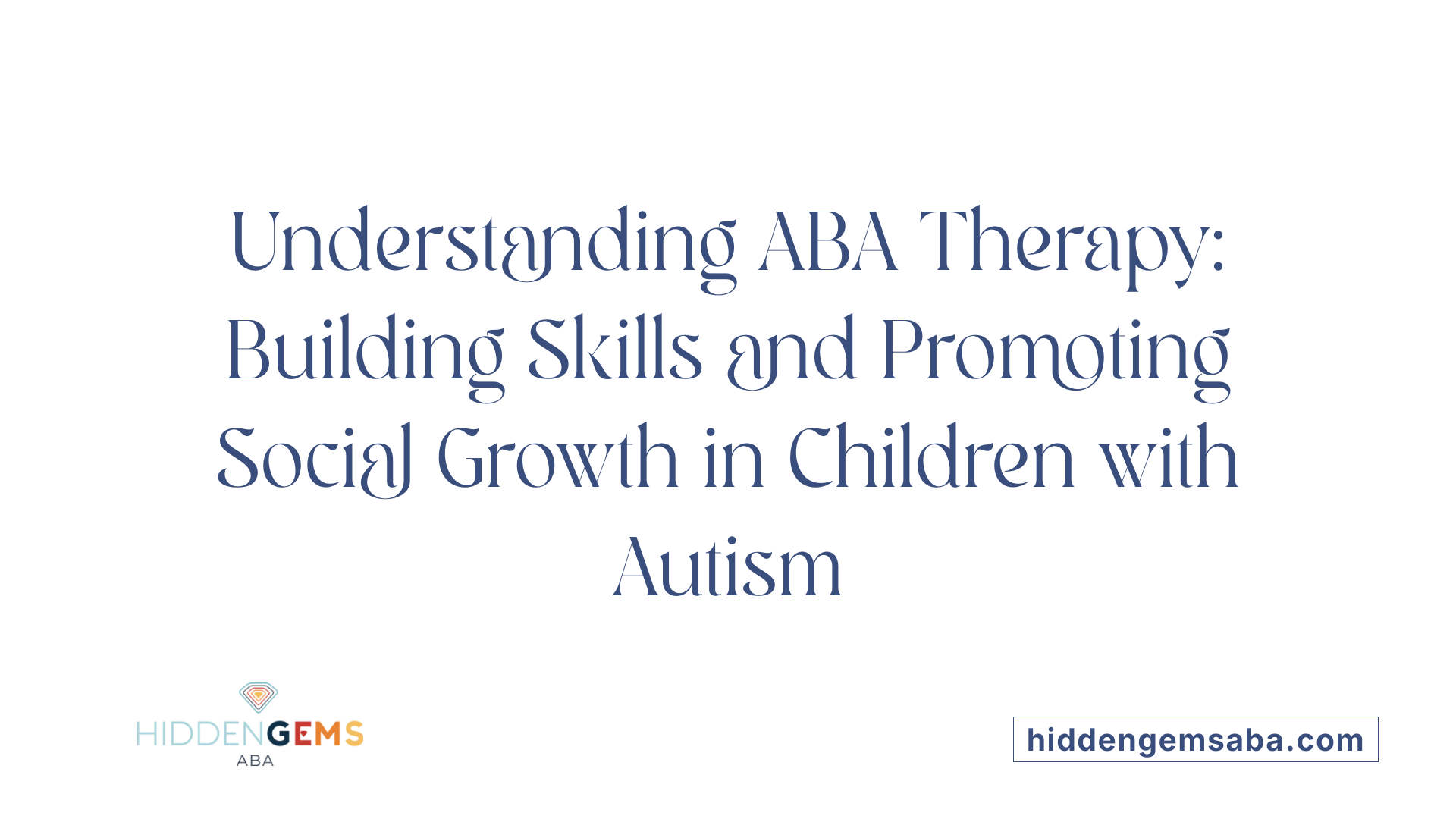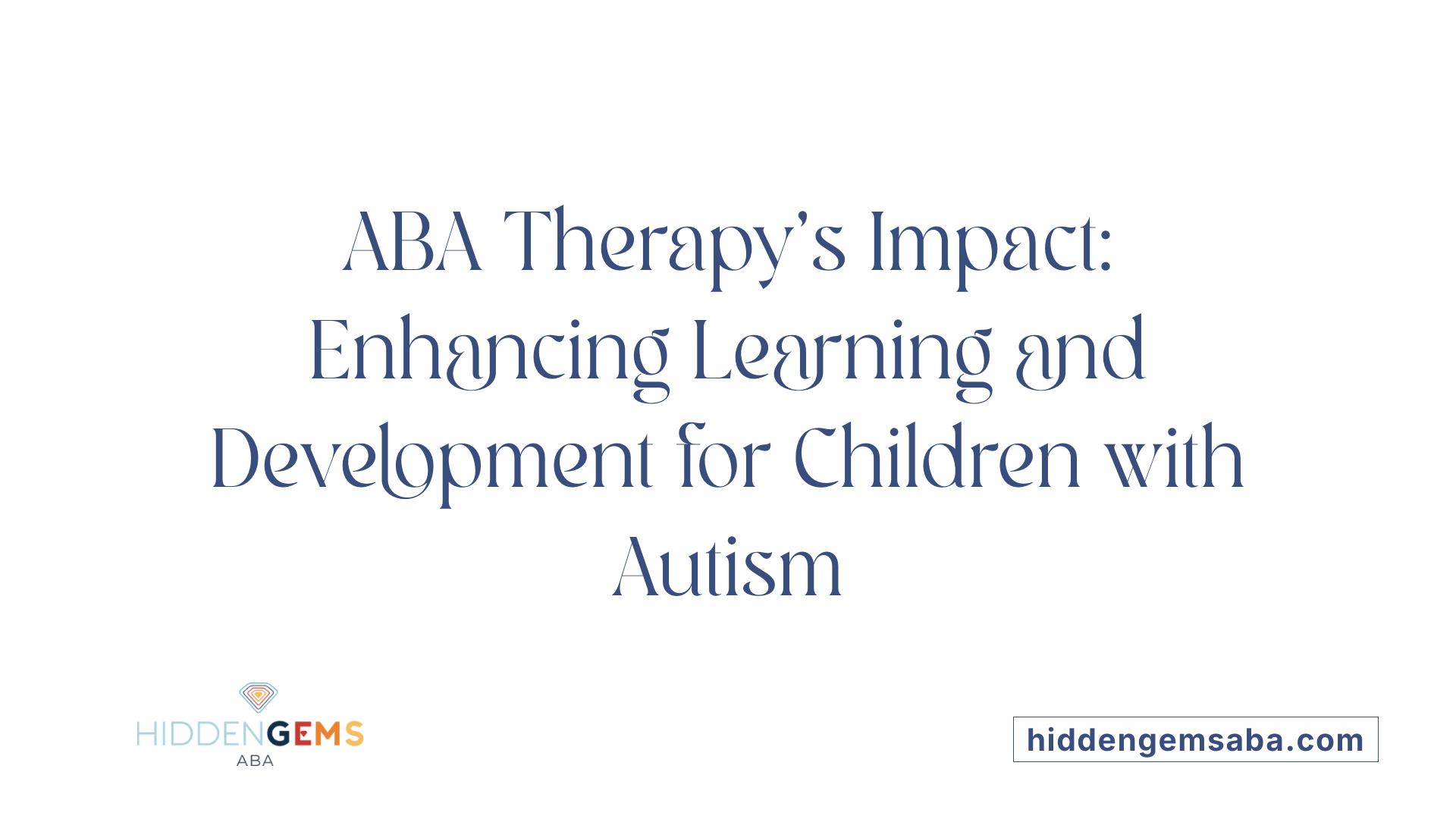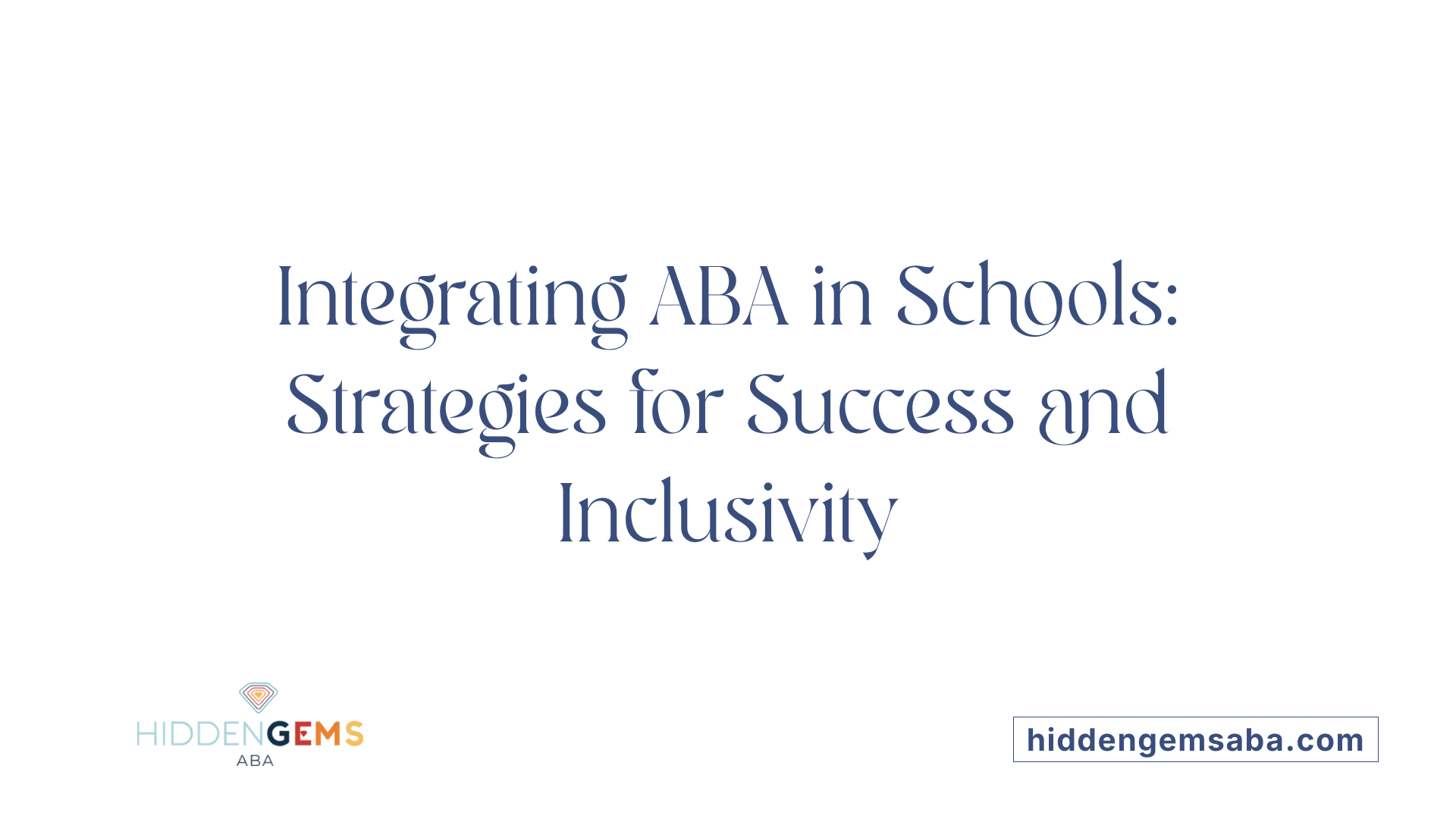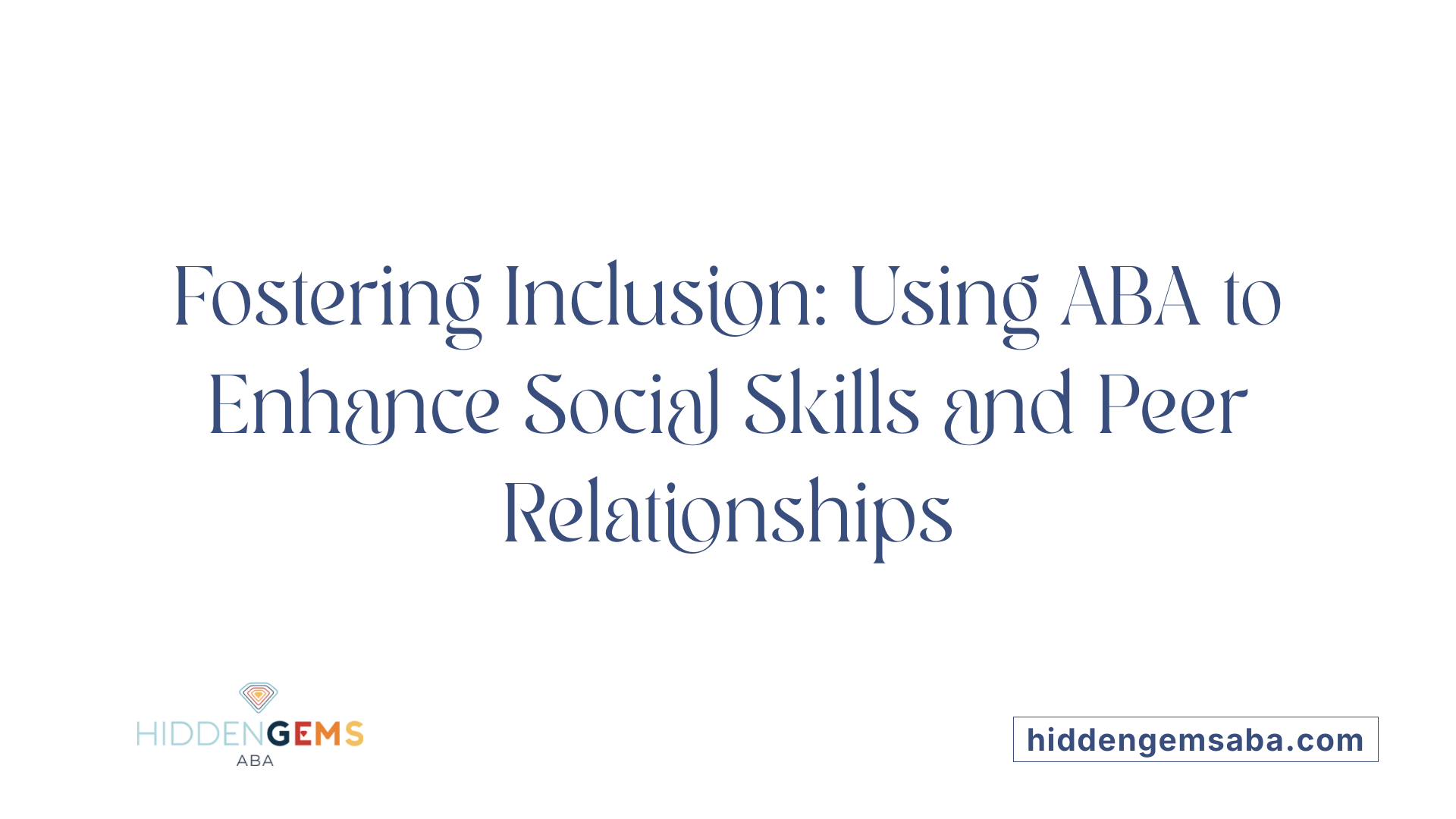Understanding ABA Therapy's Role in Supporting Autism in Educational Settings
Applied Behavior Analysis (ABA) therapy has emerged as a cornerstone intervention for children with autism spectrum disorder (ASD). Its scientific, evidence-based approach targets core developmental challenges, aiming to improve communication, social skills, and daily functioning. This article explores how ABA therapy influences academic success, behavioral development, and social integration within educational environments, shaping brighter futures for children on the spectrum.
What is ABA Therapy and Its Support for Children's Learning and Social Growth

What is ABA therapy, and how does it support children with autism in their learning and social development?
Applied Behavior Analysis (ABA) therapy is a scientifically supported method designed to help children with autism develop vital behavioral and social skills. This approach is based on understanding behavior through learning principles and using systematic techniques to encourage positive changes.
ABA therapy employs reinforcement strategies — rewarding desirable behaviors — to increase their occurrence. It also involves modifying environmental factors to reduce challenging behaviors and promote adaptive ones. For example, a child might receive praise or tokens after successfully completing a task or demonstrating appropriate social interaction.
Delivery of ABA therapy can take place in various settings, including at home or in educational environments. These contexts allow for consistent reinforcement and targeted intervention tailored to individual needs.
The therapy aims to develop a wide range of skills: communication—both verbal and non-verbal—social interaction, academic abilities, and daily living tasks. Techniques such as Discrete Trial Training (DTT) help children learn specific skills through repeated practice. Natural Environment Teaching (NET) fosters skill generalization in everyday situations.
Because every child is different, ABA programs are customized. An assessment of a child's strengths and challenges guides the development of personalized learning plans. These plans set clear goals for progress in communication, behavior, and social skills.
Research shows that early and intensive ABA intervention significantly benefits children with autism, leading to improvements in IQ, language, adaptive behaviors, and social participation. This approach promotes independence and helps children integrate more fully into their home, school, and community settings.
| Techniques in ABA Therapy | Focus Area | Description |
|---|---|---|
| Discrete Trial Training (DTT) | Skill Acquisition | Systematic teaching through repeated trials and prompts |
| Natural Environment Teaching (NET) | Generalization | Learning skills in real-life contexts |
| Functional Communication Training (FCT) | Communication | Replacing behaviors with effective communication |
| Peer Modeling | Social Skills | Learning social interaction through peers |
The comprehensive, goal-oriented process of ABA supports children with autism in building essential skills for lifelong success and social inclusion.
Effectiveness of ABA Therapy in Elevating Educational Outcomes
 Research evidence consistently shows that ABA therapy significantly enhances educational and developmental outcomes for children with autism spectrum disorder (ASD). Numerous studies and meta-analyses, which compile data from multiple research projects, report substantial improvements in IQ scores, communication abilities, social skills, and adaptive behaviors among children undergoing ABA interventions.
Research evidence consistently shows that ABA therapy significantly enhances educational and developmental outcomes for children with autism spectrum disorder (ASD). Numerous studies and meta-analyses, which compile data from multiple research projects, report substantial improvements in IQ scores, communication abilities, social skills, and adaptive behaviors among children undergoing ABA interventions.
Meta-analytic findings reveal effect sizes indicating remarkable gains in language development and cognitive functioning, especially when therapy is initiated early and delivered intensively. For example, studies suggest that children who start ABA therapy at a young age and participate in long-term, consistent sessions tend to show more pronounced improvements.
The role of early intervention is particularly important. Children receiving ABA therapy in their preschool years often experience faster developmental progress, helping them better engage in classroom activities and social interactions. This tailored approach addresses individual needs, targeting specific behaviors and learning goals.
While some variability exists across research findings, the overall consensus emphasizes that ABA is an effective, evidence-based approach to support children with autism. It helps improve intellectual abilities, language skills (both expressive and receptive), and socialization. These improvements not only foster academic success but also promote better emotional well-being.
In summary, the abundance of scientific data, including meta-analyses with significant effect sizes, underscores ABA therapy’s role as a highly effective intervention for enhancing educational outcomes and overall development in children with ASD. Continued research is essential to further refine strategies and maximize benefits.
Strategies for Integrating ABA into Educational Settings

What strategies are used to integrate ABA therapy into educational settings?
Successfully incorporating ABA principles into schools requires a multifaceted approach. Central to this is the development of individualized behavior support plans and personalized education plans (IEPs). These plans are tailored to each student's unique needs, outlining specific goals and intervention strategies.
Staff training is another critical component. Educators, therapists, and support staff receive specialized instruction on evidence-based ABA techniques. Common methods include Discrete Trial Training (DTT), Natural Environment Teaching (NET), and Pivotal Response Treatment, which emphasize reinforcement strategies like token economies or praise to promote positive behaviors.
Classroom environment modifications play a vital role in supporting these interventions. Visual supports, clear routines, and structured spaces help reduce anxiety and encourage engagement. Visual schedules and cues make expectations explicit, fostering independence and reducing disruptive behaviors.
Collaboration among therapists, teachers, and families ensures the consistency and fidelity of ABA interventions. Regular meetings and communication help align strategies and share progress updates, creating a unified support system for the student.
Continuous progress monitoring through systematic data collection is essential. Data helps track behavioral changes and skill acquisition, allowing educators to modify strategies as needed. This dynamic process ensures that interventions remain effective and responsive to the child's evolving needs.
Combining these strategies creates an inclusive environment that not only enhances social, communication, and academic skills but also promotes the generalization of skills across different settings. Implementing ABA thoughtfully in schools supports children with autism in achieving greater independence and social participation.
How ABA Therapy Enhances Behavioral Skills for Academic Success

How does ABA therapy contribute to behavioral development that supports academic success?
ABA therapy plays a crucial role in fostering behaviors that are essential for thriving in an academic setting. It focuses on developing foundational skills such as attention, compliance, communication, and social interaction. These skills serve as a base for effective learning and classroom participation.
In schools, ABA employs tailored strategies grounded in research, including positive reinforcement, prompting, and consistent routines. These methods encourage children to stay engaged, follow instructions, and complete tasks reliably. For example, using reinforcement systems helps children understand the connection between their behavior and positive outcomes, motivating continued effort.
Another important aspect is the generalization of skills across different environments. ABA interventions ensure children can apply what they learn not just during therapy sessions but also during classroom activities, recess, and lunch. This broad application supports their independence and adaptability, making them more comfortable and competent in diverse settings.
Collaboration among caregivers, teachers, and therapists is vital. By working together, they create personalized intervention plans that address each child's unique behavioral and academic needs. This teamwork guarantees consistency and reinforces progress across all areas of the child's life.
Ultimately, ABA fosters behavioral and social-emotional development, laying a sturdy foundation for academic achievement. Children become better equipped to focus on lessons, interact positively with peers, and manage their behaviors independently. These improvements lead to a supportive classroom environment where children can excel and develop confidence in their abilities.
| Aspect | Approach | Outcomes |
|---|---|---|
| Foundational skills | Attention, compliance, communication | More engaged, better task completion |
| Behavior strategies | Reinforcement, prompting, routines | Consistent behaviors, predictability |
| Skill generalization | Across environments (classroom, recess, lunch) | Greater independence, adaptability |
| Collaboration | Caregivers, teachers, therapists | Tailored, effective interventions |
| Long-term impact | Independence, social skills, adaptability | Academic success, peer relationships |
Research Insights into ABA's Impact on Development and Academic Growth
What does current research say about the impact of ABA therapy on development and academic achievement in children with autism?
Research indicates that ABA (Applied Behavior Analysis) is a scientifically supported approach that significantly improves multiple developmental domains in children with ASD (Autism Spectrum Disorder). Evidence from numerous meta-analyses shows moderate to large effect sizes, particularly in areas such as intellectual functioning, language development, and social skills.
Meta-analytical studies report an average effect size of about 0.74 for increasing IQ scores and expressive language skills, signaling substantial cognitive gains. Receptive language also improves with an effect size near 0.60, reflecting better understanding and comprehension.
In terms of social abilities, effect sizes average around 0.44, indicating meaningful progress in socialization and interaction. These findings support the idea that consistent ABA intervention can foster enhanced communication, adaptive behaviors, and overall cognitive development.
Longitudinal research demonstrates that children who receive early and intensive ABA therapy tend to maintain these improvements over time. Studies within healthcare systems show sustained benefits, especially for children with prior special education experience, although the full dose of therapy is often challenging to achieve in practice.
Most notable improvements have been observed in adaptive skills, which include daily living activities and self-care behaviors. Gains are frequently evident after 24 months of intervention, particularly in children who initially exhibit lower adaptive functioning.
However, some areas such as language development, symptom severity reduction, and parental stress levels show mixed results. This indicates a need for further research to clarify how different intervention intensities, starting abilities, and family factors influence long-term outcomes.
In conclusion, current scientific findings affirm that ABA therapy is highly effective in enhancing developmental and academic skills in children with autism, though individual responses can vary. Continuous investigation is essential to optimize strategies and extend understanding of long-term benefits.
Core ABA Techniques and Their Role in Skill Acquisition
What are Discrete Trial Training (DTT), Natural Environment Teaching (NET), Peer Modeling, and Functional Communication Training (FCT)?
Discrete Trial Training (DTT) is a structured teaching method that involves breaking down skills into small, manageable steps. Each step is taught through repeated trials, with prompts and reinforcement to encourage correct responses.
Natural Environment Teaching (NET) emphasizes teaching skills in real-life settings. It uses natural opportunities to develop communication, social, and daily living skills by engaging children in typical activities.
Peer Modeling involves children observing and interacting with peers who demonstrate desired behaviors. This approach encourages imitation and social learning in a natural context.
Functional Communication Training (FCT) helps children replace challenging behaviors with appropriate communication methods. It teaches children to express their needs and desires effectively.
How do these techniques support learning?
DTT provides clear, consistent instruction ideal for introducing new skills. It helps children master foundational behaviors such as following directions or identifying objects.
NET fosters generalization by applying skills in everyday situations. It encourages spontaneous use of communication and social skills.
Peer Modeling enhances motivation and learning by leveraging social influence. Children are often motivated to imitate peers they admire.
FCT reduces problematic behaviors by teaching functional alternatives, enabling children to communicate their needs without frustration or aggression.
Integration in educational programs
These methods are often combined within individualized behavior plans. Teachers and therapists tailor activities to each child's goals, ensuring skills transfer across settings.
Utilizing these core techniques allows for comprehensive development, including communication, social interaction, and independence, which are critical for children with autism.
Promoting Inclusion and Social Skills in School through ABA

How does ABA promote peer relationships?
Applied Behavior Analysis (ABA) encourages positive peer interactions by teaching children with autism specific social behaviors. Through structured activities like Peer Modeling, children learn to imitate and practice making friends, sharing, and cooperating.
How does ABA foster teamwork among students?
ABA interventions emphasize cooperative tasks that require students to work together, reinforce teamwork, and develop social understanding. These methods cultivate skills such as taking turns and supporting peers during group activities.
How are communication skills improved with ABA?
ABA focuses on developing both verbal and non-verbal communication skills. Techniques such as Functional Communication Training (FCT) teach children to express needs and feelings appropriately, leading to better social interactions.
What inclusive strategies are used in classrooms?
Classroom strategies include visual supports, structured routines, and reinforcement systems tailored to each child's needs. These create a consistent environment, making social participation accessible for children with autism.
| Strategy Type | Description | Benefit | Example |
|---|---|---|---|
| Peer Modeling | Learning through peer interaction | Enhances social skills | Children observe and imitate peers in play |
| Reinforcement Systems | Reward desirable behaviors | Promotes engagement | Praise or tokens for sharing or participating |
| Visual Supports | Use of pictures or schedules | Clarifies expectations | Visual cues for classroom routines |
| Structured Routines | Consistent daily schedule | Reduces anxiety and promotes participation | Fixed time for social activities |
| Data Collection | Monitoring progress | Adjusts interventions as needed | Recording social interactions |
Incorporating ABA in schools creates an inclusive, supportive learning environment. It helps students develop crucial skills while fostering social bonds, making classrooms more welcoming for everyone.
Collaborative Approaches and Benefits of School-Based ABA Programs
How does team collaboration among therapists, teachers, and families enhance the success of school-based ABA programs?
Successful ABA interventions in schools rely heavily on teamwork. When therapists, teachers, and families work together, they share insights about each child's needs and progress. This collaboration ensures that strategies are consistent across different settings and that all involved are aligned in their goals.
Why is professional development important for staff implementing ABA in schools?
Training teachers and support staff in ABA principles equips them with the skills needed to deliver effective interventions. Ongoing professional development helps staff stay updated on the latest techniques, ensuring therapeutic consistency and improving student outcomes.
How do creating consistent intervention plans support student progress?
Developing tailored, consistent plans based on functional assessments helps target specific behaviors and skills. Consistency across environments—home, school, and therapy—reinforces learning and decreases confusion or frustration for students.
What is the role of monitoring progress and adjusting strategies?
Regular data collection and analysis allow educators and therapists to evaluate if goals are being met. When progress is slow or setbacks occur, strategies can be refined or changed, maximizing the chances of success.
How does fostering inclusive and supportive learning environments benefit children with ASD?
Inclusive environments that incorporate ABA strategies promote social interaction, acceptance, and independence. When schools create such spaces, children with ASD can thrive academically and socially, building skills that help them integrate fully into their communities.
| Aspect | Description | Additional Notes |
|---|---|---|
| Team Collaboration | Coordinated efforts among all stakeholders | Ensures consistency and shared understanding |
| Professional Development | Training and ongoing education | Keeps staff updated with best practices |
| Intervention Plans | Personalized strategies based on assessments | Adapted to each child's needs |
| Monitoring & Adjustment | Regular tracking and plan revisions | Improves effectiveness over time |
| Inclusive Environment | Supportive classroom settings | Encourages social and academic growth |
Concluding Remarks: The Future of ABA in Education and Autism Support
Ongoing research continues to highlight the effectiveness of Applied Behavior Analysis (ABA) in improving social, communication, and adaptive skills in children with Autism Spectrum Disorder (ASD). Studies, including recent trials involving diverse age groups and settings, reinforce the importance of early and intensive intervention for optimal outcomes.
However, there is a recognized need for further studies to explore long-term effects, refine intervention techniques, and identify the most effective components of ABA therapy. Researchers are also examining how ABA can be integrated with other therapeutic approaches to enhance overall support for individuals with ASD.
The potential for broader application of ABA extends beyond clinical settings into mainstream education. As evidence mounts, schools and community programs are increasingly adopting ABA principles to foster inclusive environments, promote social inclusion, and support academic success.
Early intervention remains crucial. Initiating ABA therapy at a young age can significantly influence developmental trajectories, leading to better social and communication skills, increased independence, and improved quality of life.
Overall, ongoing advances and emerging research underscore the importance of continued innovation in ABA practices. These efforts aim to tailor interventions more precisely, expand access, and ultimately improve lifelong outcomes for individuals on the autism spectrum.
Summing Up: Transforming Lives through ABA and Education
ABA therapy stands as a scientifically proven, versatile intervention that significantly bolsters the educational and social development of children with autism. Its tailored, evidence-based strategies not only improve communication, social skills, and behavioral regulation but also lay a robust foundation for academic success. When integrated into educational settings through collaborative efforts and best practices, ABA empowers children with ASD to reach their full potential, achieve greater independence, and foster inclusive learning environments. As research continues to validate and refine ABA interventions, the future promises expanded opportunities for children on the spectrum to thrive academically, socially, and emotionally.
References
- The Impact of ABA Therapy on Children With Autism | PMT
- Enhancing Classroom Success: The Impact of ABA Therapy on ...
- School-Based ABA Therapy: Success for Children with Autism
- Integrating ABA Therapy in Schools: Strategies for Success
- The effectiveness of applied behavior analysis program training on ...
- ABA Therapy Success Rate: Should You Go for it? | BIFA
- The effectiveness of applied behavior analysis program training on ...
- Patient Outcomes After Applied Behavior Analysis for Autism ...

.jpg)




